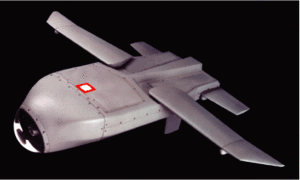Low Cost Autonomous Attack System
| LOCAAS | |
|---|---|
|
Artist conception of LOCAAS | |
| Type | Small submunition-type missile |
| Place of origin |
|
| Production history | |
| Manufacturer | Lockheed Martin |
| Specifications | |
| Weight | 100 pounds (45 kg) |
| Length | 36 inches (91 cm) |
|
| |
| Warhead | Explosively formed projectile |
| Warhead weight | 17 lb (7.7 kg) |
|
| |
| Engine |
Technical Directions TDI-J45G turbojet 30 lbf (0.13 kN) thrust |
| Wingspan | 3 ft 10.5 in (1.181 m) |
Operational range |
over 100 mi (160 km) 30 minute loiter time |
| Flight altitude | 750 feet (230 m) |
| Speed | 230 miles per hour (370 km/h) |
Guidance system |
GPS/inertial midcourse LADAR terminal |
Launch platform | Bomber aircraft; MGM-140 missiles |
The Low Cost Autonomous Attack System (LOCAAS). In 1998 the U.S. Air Force and U.S. Army Lockheed Martin began to examine the feasibility of a small, affordable cruise missile weapon for use against armoured and unarmoured vehicles, materiel and personnel, and if so develop a demonstration program.[1] The program has cost approx. $150,000,000 so far; the cost per unit is calculated to be $30,000 based on a production of 12,000 units.
After being launched from a weapon platform, it is guided by GPS/INS to the target general area, where it can loiter. A laser radar (LIDAR or LADAR) illuminates the targets, determines their range, and matches their 3-D geometry with pre-loaded signatures. The LOCAAS system then selects the highest priority target and selects the warhead's mode for the best effect.[2]
It is part of the Small Bomb System (SBS) program. The LOCAAS has been cancelled.
Specifications
- Weight: 100 lb (45 kg)
- Length: 36 in (910 mm)
- Speed: 200 knots (370 km/h)
- Search altitude: 750 ft (230 m)
- Footprint: 25 sq nmi (86 km2)
- Motor: 30 lbf (130 N) thrust class turbojet.
- Range: >100 nmi (190 km)
- Loiter time: 30 min max.
- Guidance: GPS/INS with LADAR terminal seeker
- Warhead: 7.7 kg (17 lb) multi-mode explosively formed projectile (long rod penetrator, aerostable slug or fragmentation)[3]
See also
- Vertical Launch Autonomous Attack System (VLAAS)
- Surveilling Miniature Attack Cruise Missile
- GBU-53/B Small Diameter Bomb II
